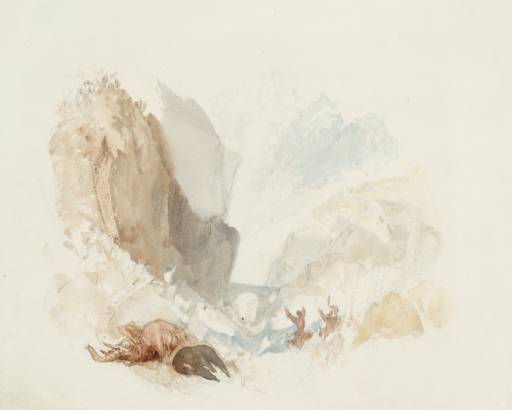Joseph Mallord William Turner Study for 'Hannibal Passing the Alps', for Rogers's 'Italy' c.1826-7
Joseph Mallord William Turner,
Study for 'Hannibal Passing the Alps', for Rogers's 'Italy'
c.1826-7
Joseph Mallord William Turner 1775–1851
Study for ‘Hannibal Passing the Alps’, for Rogers’s ‘Italy’ circa 1826–7
D27668
Turner Bequest CCLXXX 151
Turner Bequest CCLXXX 151
Pencil and watercolour, approximately 170 x 212 mm on white wove paper, 230 x 284 mm
Inscribed in pencil ‘x’ lower right-hand edge
Stamped in black ‘CCLXXX 151’ bottom right
Inscribed in pencil ‘x’ lower right-hand edge
Stamped in black ‘CCLXXX 151’ bottom right
Accepted by the nation as part of the Turner Bequest 1856
Exhibition history
1878
[Oxford Loan Collection], University of Oxford, 1878–1916 (126 and 5).
1965
[Display of watercolours from the Turner Bequest], Tate Gallery, London, circa March 1965 (no catalogue).
1975
Turner and the Poets: Engravings and Watercolours from his Later Period, Marble Hill House, Twickenham, April–June 1975, University of East Anglia, Norwich, June–July 1975, Central Art Gallery, Wolverhampton, July–August 1975 (III).
References
1878
Catalogue of Sketches by Turner Lent by The Trustees of the National Gallery to the Ruskin Drawing School, Oxford, London 1878, nos.126 (1st edition), 5 (2nd edition), as ‘Passing the Alps’.
1903
E.T. Cook and Alexander Wedderburn (eds.), Library Edition: The Works of John Ruskin: Volume I: Early Prose Writings 1834–1843, London 1903, pp.233, 244.
1904
E.T. Cook and Alexander Wedderburn (eds.), Library Edition: The Works of John Ruskin: Volume XIII: Turner: The Harbours of England; Catalogues and Notes, London 1904, pp.380–1.
1906
E.T. Cook and Alexander Wedderburn (eds.), Library Edition: The Works of John Ruskin: Volume XXI: The Ruskin Art Collection at Oxford, London 1906, p.214.
1909
A.J. Finberg, A Complete Inventory of the Drawings in the Turner Bequest, London 1909, vol.II, p.900, as ‘Hannibal crossing the Alps’.
1975
Mordechai Omer, Turner and the Poets: Engravings and Watercolours from his Later Period, exhibition catalogue, Marble Hill House, Twickenham 1975, [pp.3, 21], reproduced fig.1 (colour).
1976
Mordechai Omer, Turner und die Dichtkunst: Aquarelle; Graphik, exhibition catalogue, Bayerische Staatsgemäldesammlungen, Munich 1976, p.8, reproduced Abb.1 (colour).
1983
Cecilia Powell, ‘Turner’s vignettes and the making of Rogers’s “Italy” ’, Turner Studies, vol.3, no.1, Summer 1983, pp.6, 13 note 60.
1984
Cecilia Powell, ‘Turner on Classic Ground: His Visits to Central and Southern Italy and Related Paintings and Drawings’, unpublished Ph.D thesis, Courtauld Institute of Art, University of London 1984, p.519 note 56.
1993
Jan Piggott, Turner’s Vignettes, exhibition catalogue, Tate Gallery, London 1993, p.97.
This study is one of three preparatory drawings that Turner made for the vignette Hannibal Passing the Alps (Tate D27666; Turner Bequest CCLXXX 149), which appeared as the head-piece to the section entitled ‘The Alps’ in Rogers’s Italy.1 The two other studies are Tate D27523; Turner Bequest CCLXXX 6 and Tate D27525; Turner Bequest CCLXXX 8.
This is the most complete study of the three that Turner produced for Hannibal Passing the Alps, and relates most directly to the final version of the vignette. The artist had laid out the major features of the Alpine landscape that reappear in the finished composition. In the finished vignette the brown cliffs and blue, snow-capped mountains retain their shape, although their position in the composition has been reversed. At the centre of both images is the picturesque silhouette of a lop-sided arched bridge, which provides a strong horizontal counterpoint to the soaring verticals of the surrounding cliffs.
Although the Alpine landscape seems to be the main focus of this study, Turner also uses it to experiment with the figural content of the vignette. On the right side of the composition, two partially obscured figures descend into a ravine. Even more significant, however, are the carcasses of several animals, which are heaped into a pile in the left-hand foreground of the image. One of them is an elephant, clearly identifiable by its trunk and tusks. It is possible that this detail was inspired by Rogers’s description of an elephant and his rider tumbling to their deaths:
Trampling the snows,
The war-horse reared; and the towered elephant
Upturned his trunk into the murky sky,
Then tumbled headlong, swallowed up and lost,
He and his rider.
(Italy, p.30)
The war-horse reared; and the towered elephant
Upturned his trunk into the murky sky,
Then tumbled headlong, swallowed up and lost,
He and his rider.
(Italy, p.30)
Hannibal Passing the Alps is one of a number of Italy vignettes for which Turner produced preliminary studies that differ significantly from the design that was eventually engraved for publication. For other examples, see Venice (Tate D27710; CCLXXX 193), Florence (Tate D27673; CCLXXX 156) and Paestum (Tate D27665; CCLXXX 148). In all cases, it is clear that Turner was familiar with the content of Rogers’s poem and gave considerable thought to the process of selecting verses for illustration.
Technical notes:
Watermark: ‘J Whatman / Turkey Mill / 1826’
Watermark: ‘J Whatman / Turkey Mill / 1826’
Verso:
Inscribed by unknown hands in pencil ‘5’ and ‘a’ upper centre and ‘CCLXXX 151’ bottom centre
Stamped in black ‘CCLXXX 151’ lower centre
Stamped in black ‘CCLXXX 151’ lower centre
Meredith Gamer
August 2006
How to cite
Meredith Gamer, ‘Study for ‘Hannibal Passing the Alps’, for Rogers’s ‘Italy’ c.1826–7 by Joseph Mallord William Turner’, catalogue entry, August 2006, in David Blayney Brown (ed.), J.M.W. Turner: Sketchbooks, Drawings and Watercolours, Tate Research Publication, December 2012, https://www

